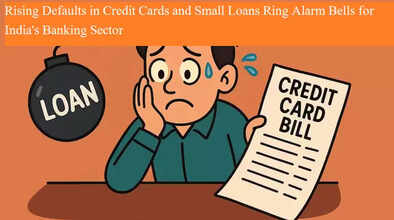Rising Defaults in Credit Cards and Small Loans Ring Alarm Bells for India's Banking Sector

India’s retail lending market is undergoing a critical stress test, with small loans showing rising default rates, signaling a warning for banks and NBFCs. According to the recently released "How India Lends FY25" report by CRIF High Mark, the pressure is mounting on small-ticket loans, particularly personal loans, home loans under ₹5 lakh, and credit card dues.
In contrast, larger loan segments are currently in a more stable position. Let’s take a deeper look into how this growing gap between small and large loans is impacting the financial sector.
Small Loans Struggling, Large Loans Remain Stable
The CRIF report clearly highlights a split in India’s retail loan market—small-ticket loans are showing signs of distress, while big-ticket loans remain relatively stable.
For instance, home loans under ₹5 lakh have seen a noticeable spike in defaults:
-
Mid-stage defaults (31–90 days overdue) rose to 4.94% as of March 2025, compared to 3.72% in March 2023.
-
Late-stage stress (91–180 days overdue) also increased from 1.62% to 1.95% in the same period.
In contrast, home loans above ₹75 lakh show improved performance, with mid-stage defaults dropping to 1.11% and late-stage stress reducing to 0.18%.
Personal Loans Below ₹1 Lakh Facing Maximum Heat
Personal loans of less than ₹1 lakh are seeing the highest stress among all segments. As per the report:
-
Late-stage defaults in this category reached 2.06% by March 2025, up from 1.50% a year earlier.
-
While personal loans above ₹1 lakh have also witnessed an increase in defaults, the intensity is far higher in smaller loans.
This surge in missed payments could impact borrowers' future cash flow and creditworthiness, especially in emergencies, where liquidity is crucial.
Two-Wheeler Loans: Bigger Loans, Bigger Risks
The two-wheeler loan segment paints a mixed picture:
-
Loans above ₹75,000 saw mid-stage defaults inch up to 3.86% in March 2025, from 3.74% in March 2024.
-
On the other hand, loans below ₹50,000 in this segment have shown signs of improvement.
Analysts believe the rising cost of vehicles is contributing to the stress in the higher-value two-wheeler loan segment.
Auto Loans Stay Stable
Auto loans have shown greater stability across the board. Loans over ₹10 lakh are gaining more traction, while the share of small auto loans (below ₹5 lakh) has fallen significantly—from 43.7% in FY22 to 30.5% in FY25. This indicates a shift in consumer borrowing patterns and preferences, possibly due to increasing automobile prices and better financing options for bigger loans.
Pressure Building on Consumer Durables and Credit Cards
Consumer durable loans in the ₹10,000–₹50,000 range have also experienced a slight increase in late-stage defaults, especially in the NBFC space, which dominates this lending category.
For credit cards, although the report doesn’t categorize defaults by ticket size, it reveals that balances overdue by more than 90 days have hit 15%. This figure is particularly concerning as recoveries become increasingly difficult after this period. The spike underscores the growing repayment stress among credit card users.
Final Thoughts: A Warning for Lenders
The CRIF report paints a clear picture: while large loan segments remain relatively secure, the rising defaults in small-ticket loans are becoming a growing concern for both banks and non-banking financial companies (NBFCs).
As economic conditions shift and household financial stress increases, lenders must tread carefully, especially in the small-loan segments where the default rate is climbing rapidly. For borrowers, this data serves as a reminder to assess repayment capacity before opting for small, easy-to-access loans that could lead to long-term financial strain.
Stay updated with the latest insights on India’s lending landscape and financial health.

